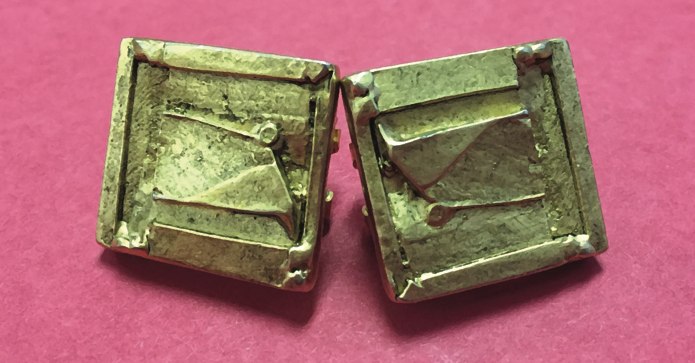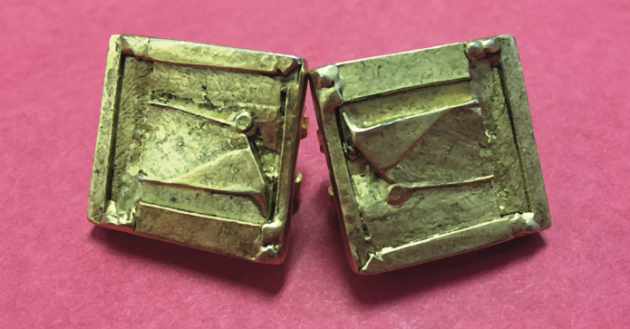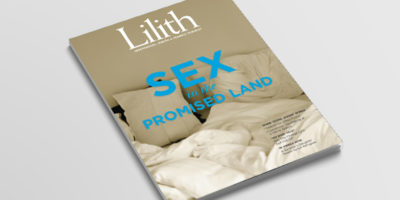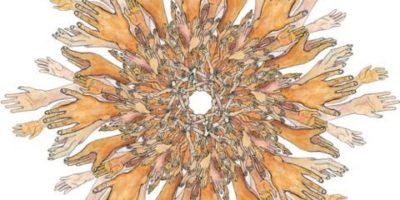
Rose Gold
Restoring the jewelry from her mother’s last day.
 When Hannah, my mother, got dressed on the morning of August 31, 2002, and put on a rose gold ring and earrings, both decorated with ruby and diamond chips, I imagine she thought of her own mother, the original owner of the set. It was festive jewelry for a festive day, each piece shaped like a small art deco fan. The rabbi’s son was celebrating his bar mitzvah across town. Carrying beige pumps, my mother walked three miles in white sneakers to the Los Angeles synagogue because she didn’t drive on the Sabbath. Her salon-dyed blonde hair was teased. Her white Anne Klein suit, bought on sale at Ross, brushed her ankles. On her way home, in a crosswalk one block from her apartment on Avenue of the Stars, a bus slammed into her. The ring scraped against the black asphalt. An earring was crushed under her facial bones.
When Hannah, my mother, got dressed on the morning of August 31, 2002, and put on a rose gold ring and earrings, both decorated with ruby and diamond chips, I imagine she thought of her own mother, the original owner of the set. It was festive jewelry for a festive day, each piece shaped like a small art deco fan. The rabbi’s son was celebrating his bar mitzvah across town. Carrying beige pumps, my mother walked three miles in white sneakers to the Los Angeles synagogue because she didn’t drive on the Sabbath. Her salon-dyed blonde hair was teased. Her white Anne Klein suit, bought on sale at Ross, brushed her ankles. On her way home, in a crosswalk one block from her apartment on Avenue of the Stars, a bus slammed into her. The ring scraped against the black asphalt. An earring was crushed under her facial bones.
A month later, my three sisters and I gathered in my mother’s eighteenth-floor apartment with its white furniture and floor to ceiling windows to divide her possessions. She had bequeathed the most valuable jewelry to us in her will. As for the rest, we set it on her granite tabletop and took turns selecting. My sister Miriam chose a tourmaline ring my mother had designed after divorcing my father and wore to replace her wedding ring. I picked a silver and amethyst bracelet I had always coveted and had occasionally helped my mother fasten because she suffered nerve degeneration in her wrists and hands, the result of an adulterated supplement she took to improve her memory and make her smarter.
As the pile of unclaimed jewelry shrank, the rose gold set became conspicuous. At the time, we were desperate to hold onto anything of my mother’s — stained clothing, suit jackets with shoulder pads from the 1980s, and costume jewelry that was so hideous we couldn’t help but laugh — but we were afraid of that set, of the disaster it represented.
The pile was nearly gone when I chose it, determined to preserve it in its damaged state. It felt holy to me. I kept it as a monument to her death, taking it out every few months and examining the mangled metal, re-experiencing each time the trauma of losing her.
I created a shrine in my home, made up of photographs in which she smiled, alive, condolence cards that reminded me I was bereft but not alone, and candles whose yellow and blue flames distracted me. You couldn’t meet me in those days without learning my mother had died and how. You couldn’t have a conversation with me without offering me tissues. The loss became part of my identity and I embraced it as I did the damaged jewelry.
Clients in my estate planning practice waited an eternity for me to draft their wills. I, who knew they might need the documents at any time, couldn’t get them done. I apologized and tried to explain. The clients were kind.
About ten years after she died, I began to think about having the jewelry repaired. There would be no going back once it was fixed, but I had begun to feel my mother would not want me to go on mourning with the intensity the jewelry inspired. She would want my memories to be of shared experiences: holidays, graduations — mine from law school and hers with a psychology doctorate — intimate talks about our divorces, and power walks around Rancho Park. I wanted to remember not her reconstructed face in a casket but the way she caressed my cheek with her fingers when she greeted me and how a few weeks before she died she held my hand for no reason, her grip firm and tender. The loss had receded as a touchstone of my identity, and I was ready to let go of its symbol, too.
A jeweler fixed the set. Pinkish metal fanning out, the pieces belong more to my grandmother’s taste and era than to my mother’s or mine. But I wear them to celebrate both our lives. When a short story of mine, “L’Chaim,” To Life, was performed on stage, I attended with my new husband and friends. I wore the rose gold jewelry, so my mother could be there too.
Rachel Maizes’s essays have appeared or are forthcoming in Lilith, The New York Times, Spirituality & Health, Moment, and Southwest: The Magazine. She is working on a collection of her widely published short stories.



